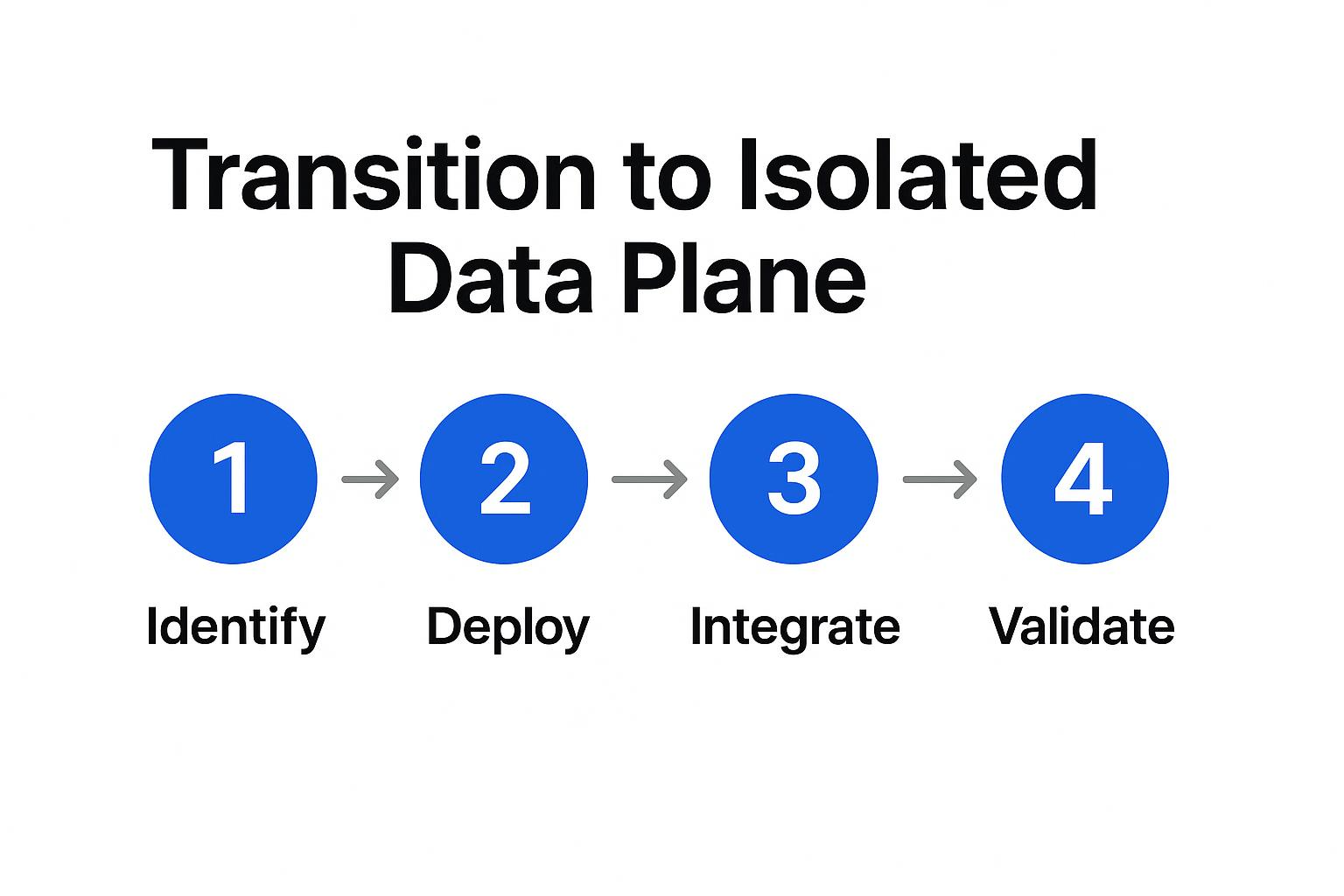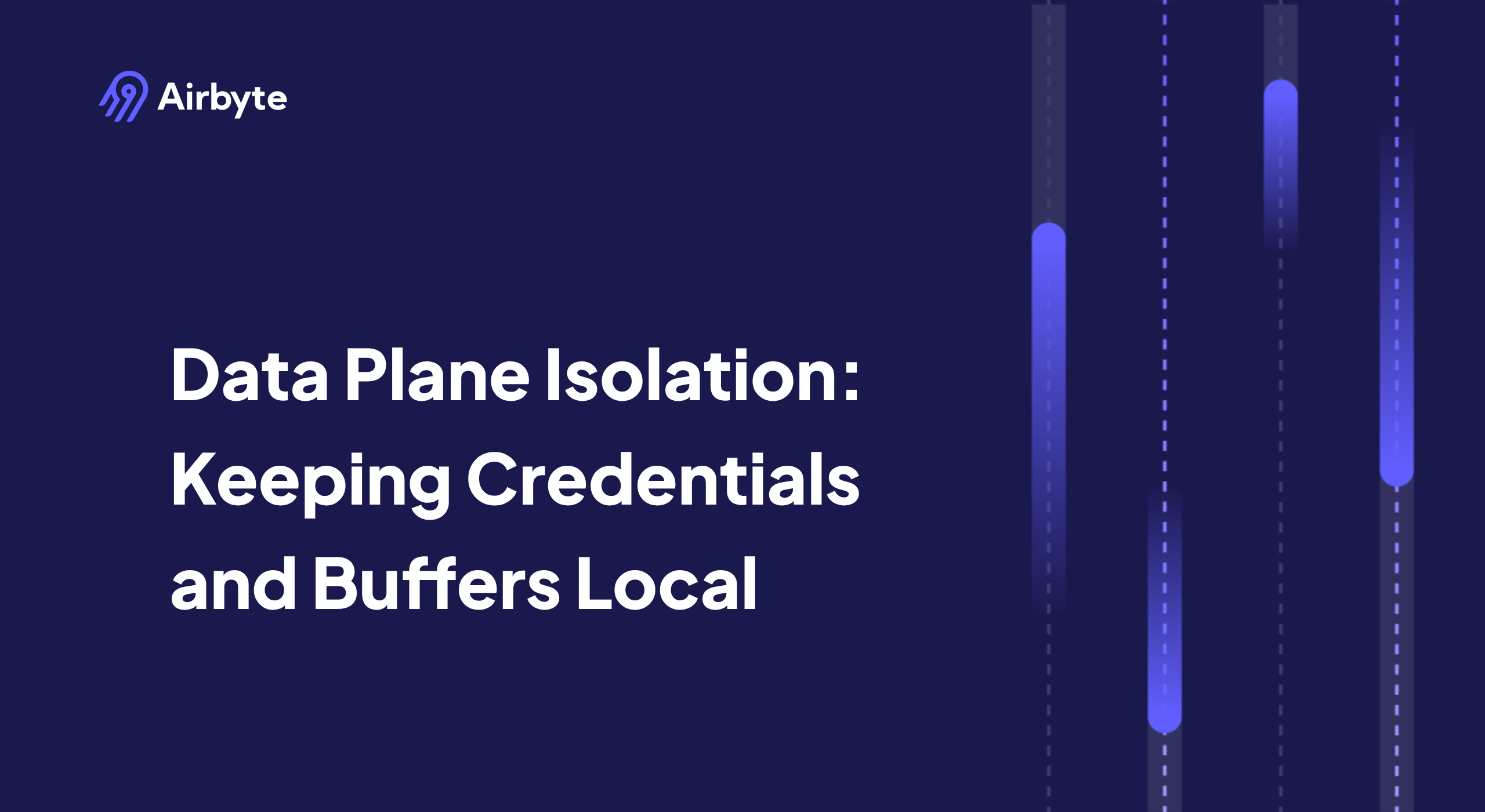Data Plane Isolation: Keeping Credentials and Buffers Local
Summarize this article with:
✨ AI Generated Summary
During market spikes, the last thing you need is a credential turning into a cross-region incident. Banks still see OAuth tokens jump from a Frankfurt cluster to a U.S. staging bucket when a shared integration service copies secrets outside the VPC. When control and data planes share resources, one intrusion can expose every tenant's keys, buffers, and logs, extending the breach far beyond the first victim. GDPR, HIPAA, and PCI DSS make that risk untenable, with auditors now expecting rigid separation between control-plane metadata outside and data-plane execution within your boundary.
Airbyte Enterprise Flex addresses this directly. We operate the cloud control plane while you run the containers that hold credentials and transient buffers. You keep orchestration convenience without surrendering secrets or your compliance posture.
What Does Data Plane Isolation Actually Mean?
Data plane isolation separates where orchestration happens from where your data movement occurs. The control plane (UI, scheduling logic, metadata services) lives in a managed environment. The data plane that executes connectors, stores credentials, and holds transient buffers stays inside infrastructure you trust.
By decoupling these layers, you create a security boundary that attackers or misconfigurations in the control plane cannot easily cross. Isolation doesn't mean air-gapping. Your data plane still initiates outbound traffic to receive job definitions or send status updates, but the control plane never reaches in. Credentials remain anchored to your own secrets manager, and buffers never leave your network.
This architecture limits the "blast radius" of a breach. A compromise in one tenant cannot pivot into another. Regulated frameworks including GDPR's cross-border transfer rules and the DORA obligations for financial services impose strict controls on how and where sensitive information can be processed, often necessitating operational transparency and contractual safeguards over data location.
By keeping execution local and supplementing it with strong controls such as locally stored audit logs, encryption, access controls, and operational transparency, you can provide auditors with clear evidence that personal data, keys, and logs never mingle in shared SaaS backplanes.
Isolated vs. Shared Data Plane Models
Isolated models preserve sovereignty by keeping execution environments within your existing network boundaries, whether that's a regional cloud VPC or an on-prem data center. Shared models trade that control for operational simplicity, and in heavily regulated sectors, that trade-off is rarely acceptable.
Why Should Credentials Always Stay Local?
Centralizing secrets inside a vendor-managed vault feels convenient until it isn't. When GitLab's production tokens disappeared during a routine maintenance window, every tenant lost access for hours. That's what happens when a single failure point sits between you and all your pipelines. A shared data plane magnifies the blast radius, while a dedicated approach keeps outages or breaches from cascading across customers.
The core defense is least-privilege access: credentials stay inside the environment that actually uses them. Local isolation prevents lateral movement. Even if the control plane is compromised, attackers can't reach the secrets that unlock production warehouses or payment APIs.
Airbyte Enterprise Flex follows this model:
- Your data plane retrieves passwords and API keys from your own AWS Secrets Manager, HashiCorp Vault, or Google Secret Manager
- The control plane never stores, sees, or requests credentials
- Every job starts with an outbound connection from the data plane to the hybrid control plane
- No inbound firewall holes needed, dramatically shrinking the attack surface
- Secrets remain within your existing RBAC and audit policies
That design matters on audit day. For example, a regional bank in Frankfurt runs Flex agents inside its EU-only VPC, pulling Snowflake keys from its Vault cluster. Pipelines sync customer transactions to Snowflake without the keys or the data ever leaving Europe, satisfying GDPR examiners without extra work from you.
How Do Local Buffers Prevent Compliance Drift?
Transient buffers sit between a source and a destination, holding rows, files, or change logs just long enough for mapping and validation. When those buffers live in a provider-controlled environment, you lose sight of where that "data in transit" actually resides. Regulators don't distinguish between at-rest and buffered data.
By moving the buffer into your own network, you create a hard boundary around every byte that leaves the source. Airbyte Enterprise Flex keeps extraction and loading inside your VPC while the managed control plane only receives job metadata over an outbound-only channel. No inbound reach-in, ever, so sensitive data never transits provider networks. Column-level hashing can further anonymize payloads when you need operational metrics without exposing raw values.
This design supports data sovereignty mandates such as GDPR and DORA by ensuring the buffer remains in the same jurisdiction as the systems it connects, but full compliance requires additional technical, contractual, and organizational measures. Isolation also tightens audit trails: every read, write, and checksum event occurs on infrastructure you control, making lineage proofs straightforward during compliance reviews. Buffers shift from an opaque risk to a verifiable control.
Data Residency Control Matrix
How Does Airbyte Enterprise Flex Implement Isolation in Practice?

Airbyte Enterprise Flex splits every deployment into a managed control plane and a customer-owned execution environment, giving you cloud convenience without surrendering sensitive assets. The control plane, hosted by Airbyte, handles UI, APIs, scheduling, and metadata. Since it never processes raw records, it can run in any region while orchestrating your jobs from a single, unified interface.
Your execution environment lives inside infrastructure you control: an on-premises cluster, a private cloud VPC, or a dedicated regional account. Here the connectors pull from sources, write to destinations, and interact with your secrets manager. All processing happens locally, so credentials, buffers, and logs stay within your compliance boundary, satisfying GDPR or HIPAA residency rules.
Communication flows one direction: outbound from your environment to the control plane. No inbound ports to expose or firewall rules to punch holes in, dramatically shrinking the attack surface and containing any potential breach.
This separation doesn't cost you functionality. Whether you deploy Airbyte Cloud or Flex, you access the same 600+ connectors, identical scheduling logic, and the open-source codebase. You keep sovereignty over data and secrets while preserving the familiar Airbyte experience your pipelines already depend on.
How Can Teams Transition from Shared to Isolated Deployment?

Moving from a shared execution model to isolated processing means tightening control where it matters most. You'll tackle the change in four steps: flag risky jobs, spin up local execution, pull secrets out of config files, and prove the new setup passes an audit. Each step builds on the last so you can move quickly without disrupting production pipelines.
1. Identify High-Risk Pipelines
Start by mapping every sync that touches regulated data: customer PII, card transactions, medical events, or security logs. Airbyte Cloud offers field-level mapping and transformation options, such as hashing or removing sensitive columns, which help manage how sensitive data is handled during sync jobs. Rank them by regulatory scope (GDPR, HIPAA, PCI DSS) and potential blast radius. The goal is a short list of pipelines that must never leave your network boundary.
2. Deploy Flex Agents in Local Infrastructure
Run an Enterprise Flex agent inside your VPC or on-prem cluster. The agent launches the same containerized connectors you already use but executes them on hardware you own. An outbound-only channel lets the hybrid control plane schedule and monitor runs without reaching into your network. Once connected, migrate the high-risk jobs you flagged in step one.
3. Integrate External Secrets Management
With execution local, shift credentials out of YAML files and into a hardened vault. Airbyte Flex supports AWS Secrets Manager, HashiCorp Vault, and other enterprise secret stores. Configure the agent to fetch short-lived tokens at runtime so human operators never see raw keys. Integrate with external secrets managers that provide automatic rotation, and restrict access by least privilege to keep breaches from cascading.
4. Validate Compliance Posture
Enable detailed logging in Airbyte Flex and store logs inside your environment, using external solutions for immutable retention if required. Map each control (encryption at rest, access reviews, network isolation) to SOC 2 or ISO 27001 checklists, then run a dry-run audit. Because your execution environment is isolated, regulators can trace every read, write, and credential use without leaving your infrastructure. Confirm that outbound-only traffic, local buffers, and external secrets all function as documented, and you're ready to expand the model to the rest of your estate.
What Operational and Compliance Outcomes Can You Expect?
With Airbyte Enterprise Flex, each pipeline runs inside its own resources, so a broken connector can't throttle peers. Finance teams report flat latency during end-of-day spikes with no more shuffling jobs to midnight. The benefits of dedicated execution include:
- Smaller failure domains that prevent cascading outages
- Faster recovery when issues occur since problems stay isolated
- Predictable performance without "noisy neighbor" effects
- No shared resource contention during peak workloads
- Ability to scale individual pipelines based on specific requirements
Credentials never traverse the control plane, eliminating cross-region drift. Secrets, transient buffers, and immutable logs stay in your VPC, shrinking the blast radius and blocking lateral movement. This delivers the core outcomes of secure isolation that security teams actually need.
Local processing satisfies GDPR residency, HIPAA's "minimum necessary" rule, and DORA's resilience tests without compromise. A European bank runs nightly Snowflake jobs through Flex while keeping keys in-country. A U.S. hospital moves HL7 feeds under the same model. Enterprise Flex gives you cloud convenience with sovereign control and no trade-offs required.
What's the Bottom Line?
True hybrid integration pairs a managed control plane with execution that never leaves your network. By isolating your processing environment, you keep credentials and transient buffers local, shrink the blast radius of any breach, and satisfy tough mandates like GDPR or HIPAA without trading away speed or Airbyte's 600+ connectors.
Talk to our team about designing an Airbyte Enterprise Flex deployment that meets your compliance bar.
Frequently Asked Questions
What is the difference between Airbyte Flex and fully self-managed Airbyte?
Airbyte Flex provides a managed control plane hosted by Airbyte while you run the data plane in your infrastructure. This gives you data sovereignty and compliance control without managing Kubernetes, upgrades, or the orchestration layer. Self-managed Airbyte means you run everything yourself, including the control plane, giving you complete control but requiring more operational overhead.
Can Airbyte Flex work with multiple cloud providers or hybrid environments?
Yes. Airbyte Flex data planes can run in AWS, Azure, GCP, on-premises data centers, or any combination. The managed control plane orchestrates jobs across all your environments through outbound-only connections, so you can maintain different data planes in different regions or clouds while managing them from a single interface.
How does Airbyte Flex handle credential rotation and secret management?
Airbyte Flex integrates with your existing secrets management infrastructure like AWS Secrets Manager, HashiCorp Vault, or Google Secret Manager. The data plane fetches credentials at runtime using short-lived tokens, and you control rotation policies through your secrets manager. The control plane never sees or stores your credentials, keeping them within your security boundary.
What compliance certifications does Airbyte Enterprise Flex support?
Airbyte maintains SOC 2 Type II and ISO 27001 certifications. Airbyte Flex's architecture supports GDPR, HIPAA, PCI DSS, and DORA compliance requirements by keeping your data, credentials, and processing within your controlled environment. The isolated data plane model makes it easier to demonstrate compliance during audits since you maintain full visibility and control over where sensitive data is processed and stored.

.webp)
